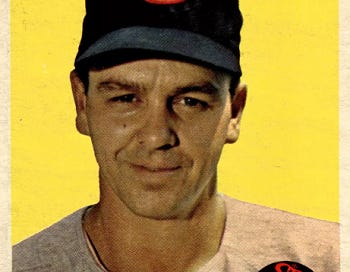Note: When you click on links to various merchants in this newsletter and make a purchase, this can result in this newsletter earning a commission. Affiliate programs and affiliations include, but are not limited to, the eBay Partner Network.
1958 Topps Dick Williams (#79) - Card of the Day
Dick Williams was the Padres manager at the first major league game I ever attended. That was in June of 1984, and by then, the Padres were already turning some heads as surprise contenders in the old National League West.
And, aside from Tony Gwynn, who was batting in the .360s as the weather got really hot, Williams was one of the more recognizable faces on the team. It’s not every club that has Wilford Brimley as a skipper, after all.
So, yeah, I was sorta star-struck watching Williams deliver the lineup card before the game. Reds manager Vern Rapp, not so much.
Little did I know at that time that Williams had once been a solid major leaguer in his own right, a super utility sort who could crank up some pop at the plate on occasion. Not only that, he also played a bit role in a complicated dance that eventually led to an iconic home run record.
Here’s how it went (and hold onto your Sox…er, socks)…
In June of 1956, the Orioles plucked Williams off the waiver wire from the Brooklyn Dodgers. He smacked 11 long balls in Baltimore while playing just 94 games the rest of the summer.
A year later, the O’s flipped the “slugger” to the Indians, who were looking for some pop. Despite Williams’ single homer to that point in 1957, the Tribe saw fit to surrender Jim Busby in exchange.
That deal went down on June 13, exactly 67 years ago today, and it led directly to the Williams-Orioles marriage in the 1958 Topps set that you see up above.
The Indians already had their outfield full, with Rocky Colavito in right field, Gene Woodling in left, and rookie Roger Maris in center…but also in left when Woodling took a day off.
That meant Williams would have to expand his horizons — he had been primarily an outfielder in Baltimore — so he played 19 games at third base, 17 in left field, and 22 in center.
With Williams now backing up both those OF slots, manager Kerby Farrel planted Maris pretty firmly in center for the rest of the summer.
Then in December, the Indians traded Al Smith and Early Wynn to the Chicago White Sox for Minnie Miñoso and Fred Hatfield, a trade which will become relevant here in a minute.
That same month, December of 1957, the White Sox traded Larry Doby, Jack Harshman, Russ Heman, and Jim Marshall to the Orioles for Tito Francona, Billy Goodman, and Ray Moore.
Doby, of course, was a Cleveland icon, but the Indians had traded him to the White Sox in October of 1955 for (yes) Busby and Chico Carrasquel.
But Doby would never appear for the White Sox, and Williams would never again appear for the Indians.
That’s because, on April 1, 1958, as the new season dawned, Cleveland traded Williams, Bud Daley, and Gene Woodling to the Orioles for Doby and Don Ferrarese.
Back in Cleveland, Doby slid back into his center field role, which would have pushed Maris back to left field, except Miñoso was there. Colavito was still in right.
For Maris, that meant mostly bench time, but the 34-year-old Doby was aging, so the young slugger filled in for the old in center on occasion — when rookie Gary Geiger wasn’t filling that role.
Miñoso, also 34, led the team with 149 games played, including 145 starts in left.
Meanwhile, made just 129 appearances in right, and Maris picked up the slack in 23 others, after just seven there in 1957.
All that congestion and Maris’ ability to slide around the outfield, and to play right field, made June 15, 1958, possible…maybe inevitable.
On that date, the Indians sent Maris, Dick Tomanek, and Preston Ward to the Kansas City Athletics for Woodie Held and Vic Power.
Maris hit 19 home runs in the final 99 games for K.C., then 16 more in 1959.
In the meantime, guess who joined him on the trail west? Yep, none other than Dick Williams — the Orioles traded him to the Athletics in October of 1958 for Chico Carrasquel.
Williams matched Maris’ homer total in 1959, and it looked like the two were entrenched — entrenched, I tell you — as the Athletics’ power source for the next decade.
Except, of course, for the little issue of the Yankees treating the A’s like their own personal 4A team.
With Maris showing himself a capable right fielder, and with Yanks right fielder Hank Bauer heading into the offseason at 37 years of age, could a deal be far behind?
Nah.
On December 11, 1959, the Bombers sent Bauer, Don Larsen, Norm Siebern, and Marv Throneberry to Kansas City in exchange for Maris, Joe DeMaestri, and Kent Hadley.
That deal worked out pretty well for the Yankees and Maris, who was rubbing elbows with Mickey Mantle and the ghost of Babe Ruth before you knew it.
And Williams?
Well, he ended up back in Baltimore, again, in 1961 and 1962 before wrapping up his playing career with two seasons in Boston
From there, it was on to Quaker Oats and disapproving glares from the dugout.
—
So that’s a lot of player movement, and there’s a good chance I misstepped somewhere along the line through the mental gymnastics routine that got us from there to here.
I think I’ll stop for the day, but the next time you’re watching Cocoon or clips of the early 1970s A’s, just remember that there’s some Roger Maris flavoring in there somewhere.
Thanks for reading.
—Adam
Like these stories and want to support them? Now you can Buy Me a Coffee.





